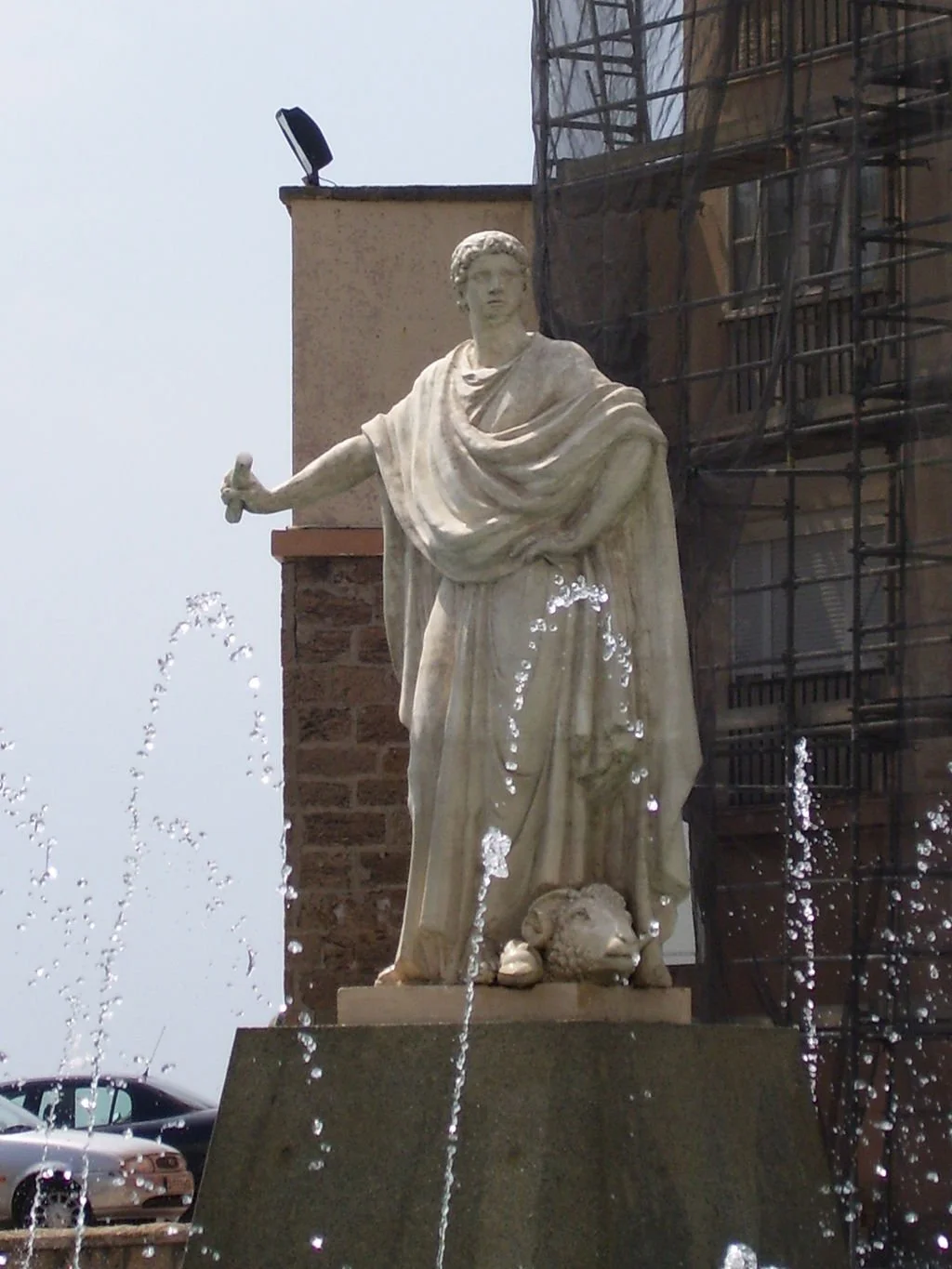Cornelius Balbus' expedition into the heart of the central Sahara in 19 BCE reads like one of those stubborn footnotes that suddenly throws a spotlight on the limits and ambitions of Rome. Ordered during Augustus' long reign of consolidation, the campaign against the Garamantes, a long-established people centered in the Libyan Fezzān (with a capital often written as Garama or Germa), was not an attempt to annex a vast Saharan empire so much as a punitive and strategic effort: to punish raiding that menaced Roman North Africa, secure trans-Saharan trade routes, and demonstrate imperial reach beyond the familiar Mediterranean littoral.
Terry Bailey explains.
Lucius Cornelius Balbus statue in Cadiz, Spain. Source: Peejayem, available here.
Ancient literary sources record that Lucius (or sometimes rendered as Cornelius) Balbus celebrated a triumph in Rome after operations in the region, and later Roman authors, chiefly Pliny the Elder and writers summarized by Cassius Dio, place a handful of Garamantian settlements under Roman pressure or control around that time.
What actually happened on the ground and how far south Balbus' columns pushed, remains a matter for cautious reconstruction rather than neat storylines. Classical authors describe the Garamantes as a confederation that could strike along the coastal provinces and carry on a lively inland commerce; in 19 BCE the Romans, led by Balbus, are said to have captured multiple settlements and brought back evidence of victory to Rome, enough to earn a public triumph recorded on the Roman fasti.
Ancient historians framed the campaign as both corrective and economic: remove the threat of raids that harmed coastal cities such as Leptis Magna, and (if possible) open or safeguard commercial arteries feeding Roman markets. However, the surviving literary traces are short on operational detail and generous on Roman self-description, so scholarship treats the narratives as a starting point, not a literal map.
Archaeology has been invaluable in turning those literary hints into a more concrete picture of Garamantian power and how an outsider like Balbus might have engaged it. The Garamantes were far from the purely nomadic caricature of some classical writers: excavations and surveys across the Fazzān have exposed permanent settlements, cemeteries of distinctive tomb-pyramid forms, irrigation systems (the foggaras or qanat-like galleries) that tapped fossil aquifers, and networks of forts and farmed oases that made sedentary agriculture possible in the now hyper-arid landscape.
Satellite imagery and field survey in recent decades have revealed rings of forts and the outlines of defended centers in and around Germa. These Garamantian capital installations could be the objective or the spoils of a Roman punitive expedition. This material context helps explain why Romans would bother to project force into the Sahara: the Garamantes controlled water, people, and routes that mattered to commerce and coastal security.
Direct archaeological evidence pointing specifically to Balbus' 19 BCE raid is necessarily limited. Unlike a campaign that left garrison forts with Latin inscriptions, the available material tends to show interaction rather than long-term occupation: imported Roman goods and amphorae found at Garamantian sites, references in Roman placards (the Fasti Triumphales) to Balbus' triumph, and the wider circulation of objects such as carnelian beads that testify to Saharan long-distance trade.
Sources of traded materials
Scientific work tracing the sources of traded materials, for instance studies on carnelian provenance from the Fazzān supports the interpretation that the region was enmeshed in exchange networks linking sub-Saharan Africa, the Sahara, and the Mediterranean. In other words, archaeology corroborates the literary claim that Garamantian centers were prosperous and connected and therefore plausible targets for a high-profile Roman campaign even if it does not produce a single, unambiguous "Balbus layer" in the sand.
Modern archaeological narratives also complicate the older Roman story. Where some classical writers presented the Garamantes as perennial raiders, the material record shows complex, largely sedentary settlements with irrigation engineering that required organized labor and administration. Recent surveys and excavations argue for a polity that could sustain agriculture, fortifications and caravan ways.
Remote sensing, (the use of satellite imagery and aerial survey), has been especially transformative: archaeologists have mapped previously invisible lines of forts, settlement clusters and irrigation channels, revealing a landscape of infrastructure rather than scattered nomads. Those same tools have fed the debate over whether Roman operations produced any lasting control; most specialists now favor the view that Balbus' action was a decisive but short-term blow that destabilized and humiliated opponents without creating long-term Roman rule deep in the Sahara.
Putting the sources together produces a balanced verdict: Cornelius Balbus' 19 BCE expedition matters less because it produced an enduring Roman province than because it reveals how far Roman imperial ambition extended, and how Mediterranean powers interacted with African polities that were neither "primitive" nor marginal. The Romans used military theatre, political spectacle (the triumphal parade in Rome) and occasional force to regulate trade and security beyond their borders; the Garamantes, for their part, were sophisticated desert engineers and traders with the resources to attract Roman attention.
Archaeology has not so much confirmed every detail of the ancient accounts as given us a richer world in which to place them: a networked Sahara of wells and foggaras, fortified towns, and caravan routes, all of which help explain why a Roman commander like Balbus would march and why Rome would brag about it in the Forum.
Today the ruins of Germa and the Fazzān remain powerful reminders of that encounter. They are fragile in the face of climate change, looting, and modern instability, but their tombs, irrigation galleries, and the scattered Roman imports found there let us read a short, vivid chapter of cross-Saharan interaction: a Roman triumph, a desert polity's engineering achievement, and the faint, material outlines of a meeting between worlds that were geographically close yet culturally distinct.
As scholarship and remote-sensing techniques progress, archaeologists may yet recover more direct remains of the 19 BCE operations, inscriptions, datable destruction layers or battlefield debris but even now the combined weight of texts and material culture makes Balbus' expedition a plausible, illuminating episode in Rome's long dialogue with Africa.
Conclusion
In conclusion, Cornelius Balbus' expedition to the Garamantes stands as a moment where history, archaeology, and imperial ambition intersect. It was not the production of new borders or the founding of colonies that gave the campaign its importance, but the symbolic weight of Rome's ability to project power into the vast Sahara and to claim victory over a people whose influence reached across desert trade routes.
The Garamantes, far from being a shadowy footnote in Roman annals, emerge through archaeology as a complex society of farmers, engineers, and traders who were both resilient and connected to broader worlds. Balbus' march thus becomes more than a fleeting military episode: it highlights the limits of empire, the realities of cross-cultural contact, and the delicate balance between spectacle and substance in Rome's dealings beyond its frontiers.
The story, refracted through ancient texts and sharpened by modern research, continues to remind us that Rome's triumphs often tell us as much about the societies it encountered as they do about the empire itself.
The site has been offering a wide variety of high-quality, free history content since 2012. If you’d like to say ‘thank you’ and help us with site running costs, please consider donating here.
Notes:
Roman fasti
The fasti were chronological lists or calendars that the Romans used to record the passage of time and important public events. Originally, the term referred to the official calendar that marked days as dies fasti (days on which legal and political business could be conducted) or dies nefasti (days when such activities were forbidden, often due to religious observances).
Over time, the scope of the fasti expanded to include records of magistrates, priests, triumphs, and other significant occurrences that structured Roman political and religious life. They were inscribed on stone or bronze tablets and often displayed publicly, ensuring that both civic order and Rome's collective memory were preserved for its citizens.
One of the most famous examples is the Fasti Capitolini, discovered in the Roman Forum during the Renaissance. These inscriptions, dating to the reign of Augustus, recorded the names of Roman consuls year by year from the founding of the Republic, alongside magistrates and notable triumphs. Such records were crucial for Roman historiography, as they provided a backbone of chronology against which events could be measured. They also carried ideological weight: Augustus, for instance, used the fasti not only to establish a coherent timeline but also to underline Rome's enduring greatness and the legitimacy of his own reign as the restorer of order.
Beyond their practical function, the fasti served as instruments of political propaganda. Recording triumphs and priesthoods, they immortalized Rome's victories and the men who achieved them, reinforcing the notion that Roman history was a continuous narrative of conquest, piety, and civic order. They were as much about shaping collective memory as about documenting the past. For example, the entry noting Cornelius Balbus' triumph after his expedition to the Garamantes ensured that his deeds were remembered in the same continuum as those of Rome's greatest generals. In this way, the fasti were not merely dry lists, but enduring symbols of Roman identity, linking religious practice, political authority, and historical consciousness in a single, monumental record.







